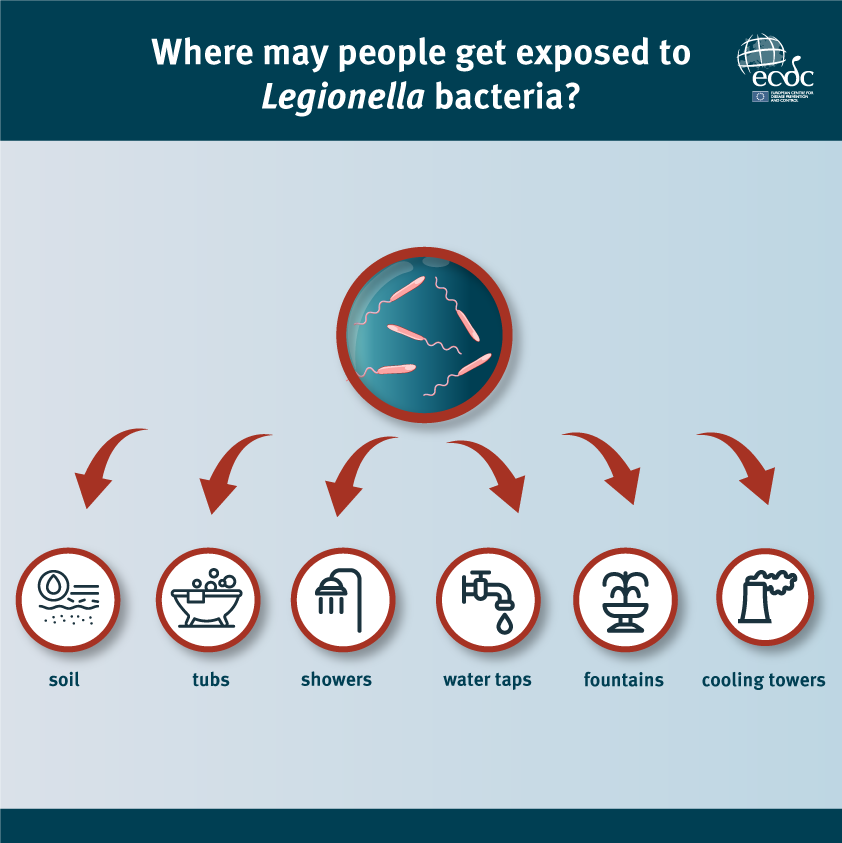Facts about Legionnaires' disease

Legionnaires’ disease is a multisystem disease which causes pneumonia due to gram-negative bacteria (Legionella spp.) found in freshwater environments around the world. Humans are infected by inhalation of aerosols containing Legionella. The infection can be fatal and outbreaks from a common environmental source can occur. Cases of Legionnaires’ disease are mainly reported in persons in older age groups, especially in males.
Why the name "Legionnaires disease"?
The bacterium responsible for Legionnaires' disease was identified in 1976, after a large outbreak at a hotel in Philadelphia, USA. The disease got its name from the group of people affected in this outbreak. They were retired American service personnel who were attending a legion convention. Since the outbreak in 1976, cases and outbreaks have been reported from all countries in Europe, many of them linked to hotels and other types of holiday accommodation.
What is legionellosis?
Legionellosis is an uncommon form of pneumonia. The disease has no particular clinical features that clearly distinguish it from other types of pneumonia, and laboratory investigations must be carried out to confirm the diagnosis. It normally takes between two to ten days to develop symptoms (typically five to six days) but very rarely some cases may take two to three weeks to develop symptoms. Patients usually start with a dry cough, fever, headache and sometimes diarrhoea and many people go on to get pneumonia. People over the age of 50 are more at risk than younger people, and males are more at risk than females. Effective antibiotic treatment is available if the diagnosis is made early in the illness. Deaths occur in about 5-15% of travellers who get the disease, depending on their age and individual health status. Smokers are more at risk than non-smokers.
How do you get legionellosis?
People become infected when they breathe in air that contains tiny droplets of water known as aerosols, inside of which are the Legionella bacteria. If the bacteria get inhaled into the lungs they can cause infection.
Legionellosis cannot be got from water you drink that enters your stomach in the normal way – the bacterium has to get into the lungs through breathing it in. The illness is not spread from person to person.
Where do the Legionella bacteria come from?
Legionella bacteria are common and can be found naturally in environmental water sources such as rivers, lakes and reservoirs, usually in low numbers. The bacteria are able to survive in the nature at a wide range of temperatures. The bacteria can multiply in man-made aquatic systems like cooling towers, evaporative condensers, humidifiers, decorative fountains, hot water systems and similar systems.
How do outbreaks occur?
Experience shows that outbreaks in hotels are mostly associated with hot or cold water distribution systems. If the bacteria is in the water in quantities that can cause infection, someone taking a shower would inhale the bacteria trapped inside the tiny aerosols that are created when the shower water hits the hard surfaces of the shower unit or bath. They may also be affected by other water systems that cause aerosols, for example whirlpool spas and fountains.
In contrast, large explosive outbreaks in the community are mostly associated with cooling towers. Cooling towers are devices used to cool buildings. They are also called “wet air conditioning systems” because the process of cooling air involves extensive contact between water and air, thereby creating aerosols. When the Legionella bacteria are present in these systems they can cause Legionnaires' disease. Air conditioning units that use water to cool the air can also pose a risk in hotels.
However, many air conditioning systems are “dry” and these pose no risk for legionellosis.
When an outbreak of legionellosis occurs, the source may be found through two types of investigation. One collects information on the activities and whereabouts of the patients with legionellosis to look for links between cases such as staying at or visiting the same places before they became ill. The other involves looking for the Legionella bacteria in the suspected water sources and in clinical specimens from the patients. If the bacteria are found in both, specialised laboratory methods are used to see if they are of the same type.




